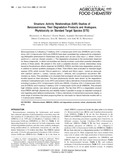| dc.description.abstract | Structure-Activity Relationships (SAR) studies of Benzoxazinones, their degradation products and analogues. Phytotoxicity on Standard Target Species (STS)
(Macías, Francisco A.; Marín, David; Oliveros, Alberto; Castellano, Diego; Simonet, Ana M. and Molinillo G., José M.)
Abstract
Benzoxazinones 2,4-dihydroxy-7-methoxy-(2 H)-1,4-benzoxazin-3(4 H)-one (DIMBOA) and 2,4-dihydroxy-(2 H)-1,4-benzoxazin-3(4 H)-one (DIBOA) have been considered key compounds for understanding allelopathic phenomena in Gramineae crop plants such as corn ( Zea maysL.), wheat ( Triticum aestivumL.), and rye ( Secale cerealeL.). The degradation processes in the environment observed for these compounds, in which soil microbes are directly involved, could affect potential allelopathic activity of these plants. We present in this work a complete structure-activity relationships study based on the phytotoxic effects observed for DIMBOA, DIBOA, and their main degradation products, in addition to several synthetic analogues of them. Their effects were evaluated on standard target species (STS), which include Triticum aestivumL. (wheat) and Allium cepaL. (onion) as monocots and Lepidium sativum L. (cress), Lactuca sativa L. (lettuce), and Lycopersicon esculentum Will. (tomato) as dicots. This permitted us to elucidate their ecological role and to propose new herbicide models based on their structures. The best phytotoxicity results were shown by the degradation chemical 2-aminophenoxazin-3-one (APO) and several 2-deoxy derivatives of natural benzoxazinones, including 4-acetoxy-(2 H)-1,4-benzoxazin-3(4 H)-one (ABOA), 4-hydroxy-(2 H)-1,4-benzoxazin-3(4 H)- one (D-DIBOA), and 4-hydroxy-7-methoxy-(2 H)-1,4-benzoxazin-3(4 H)-one (D-DIMBOA). They showed high inhibitory activity over almost all species growth. The fact that APO is a degradation product from DIBOA with high phytotoxicity and stability makes it possible to assign an important ecological role regarding plant defense mechanisms. 2-Deoxy derivatives of natural benzoxazinones display a wide range of activities that allow proposing them as new leads for natural herbicide models with a 1,4-benzoxazine skeleton.
© 2005 American Chemical Society. Published on Web 01/19/2005. | es_VE |


